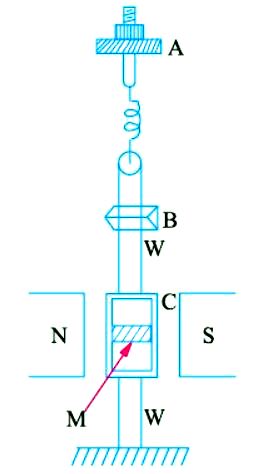Vibration Galvanometer
Vibration Galvanometers are widely used as null-point detectors in A.C. bridges.
Construction of Vibration Galvanometers
As shown in Figure A, it consists of a moving coil suspended between poles of a strong permanent magnet. The natural frequency of oscillation of the coil is very high, this being achieved by the use of a large value of control constant and a moving system of very small inertia. The suspension (which provides control) is either a phosphor-bronze strip or is a bifilar suspension in which case the two suspension wires carry the coil and a small piece of mirror (or in some cases the two suspension wires themselves from the coil.)

As seen, W is the suspension, C is the moving coil and M the mirror on which as cast a beam of light. From mirror M, this beam is deflected on to a scale. When alternating current is passed through C, an alternating torque is applied to it so that the reflected spot of light on the scale is drawn out in the form of a band of light. The length of this band of light is maximum if the natural frequency of oscillation of C coincides with the the supply frequency due to resonance. The turning of C may be done in the following two ways :
AdBlock-2
(i) by changing the length of suspension W. This is achieved by raising or lowering bridge piece B against which the bifilar loop presses.
(ii) by adjusting tension in the suspension. This is achieved by turning the knurled knob A.
By making the damping very small, the resonance curve of the galvanometer can be made sharply peaked [Figure B]. In that case, the instrument discriminates sharply against frequencies other than its own natural frequency. In other words, its deflection becomes very small even when the frequency of the applied current differs by a very small amount from its resonance frequency.

Theory of Vibration Galvanometer :
If the equation of the current passing through the galvanometer is i = Imsin ωt, then the equation of motion of the coil is :
![]()
where J, D and C have the usual meaning and G is the deflection constant.
The complementary function of the solution represents the transient motion, which in the case of vibration galvanometers, is of no practical importance. The particular integral is of the form
θ = A sin (ωt − φ)
where A and φ are constant.
Now, dθ/dt = ωA cos (ωt − φ) and d2θ/dt2 = − ω2A sin(ωt − θ).
Substituting these values in Eq. (i) above, we get
ω2JA sin (ωt − φ) + ωDA cos (ωt − φ) + CA sin (ωt − φ) = GIm sin ωt
It must be true for all values or i
When ωt = φ DA ω = G Im sin φ ……………………….(ii)
When (wt − φ) = π/2 −ω2JA + CA = G Im cos φ ………………………….(iii)
Since the phase angle φ of oscillations is of no practical significance, it may be eliminated by squaring and adding Eq. (ii) and (iii).
Since the phase angle φ of oscillations is of no practical significance, it may be eliminated by squaring and adding Eq. (ii) and (iii).

This represents the amplitude A of the resulting oscillation for a sinusoidal alternating current of peak value Im flowing through the moving coil of the galvanometer.
Read article – alternating current
Visit NCERTplanet.com for NCERT solutions and Textbook downloads




